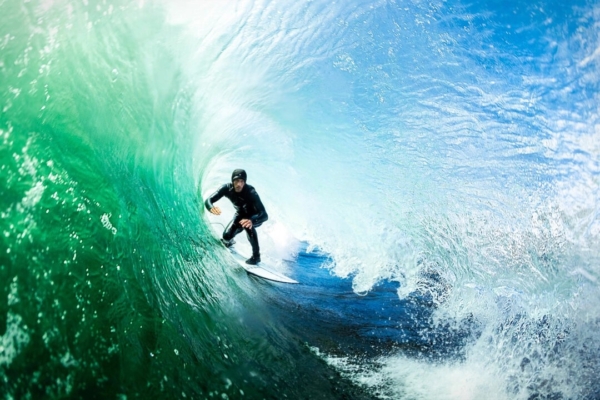In the elite surfing community, there exists a closely guarded secret – the locations of certain unparalleled waves that only those within the circle are privy to. This knowledge is acquired through years of experience riding the waves.
Through pain, dedication, respect, and humility, cold water surfer Pete Devries from Tofino, B.C., is considered one of Canada’s best surfers. Like other renowned surfers, he keeps silent about some of the massive waves he has conquered. Casual talk about these locations could pose danger to inexperienced athletes who might recklessly put themselves in harm’s way.
“I really don’t like naming waves or talking about locations,” the 41-year-old Devries said in an interview with the Epoch Times. “Most of the places we surf are quite remote, it’s a secret.”
When pressed, he only revealed “Vancouver Island”, adding that aspiring surfers must invest time to earn the opportunity to access these spots.
Devries, the 2009 Coldwater Classic champion, frequently featured in magazines like “Surfer”, “Surfline”, and Canadian Surf Journal, has 34 years of surfing experience.
Furthermore, he has endured pain for his beloved sport.
“Last winter, I took a nasty spill on a reef,” he said. “I got caught in a deep hollow wave, realized I couldn’t make it out, so I jumped forward to avoid my surfboard. It’s a standard procedure for me, I’ve done it thousands of times.”
The experienced surfer pointed out that sharp rocks, and even his own surfboard, pose significant dangers. In this particular incident, the danger came from his surfboard.
“I got catapulted too far in the barrel, my leash pulled tight, my surfboard just flew right into me,” he said. “The wave rolled me up, took me over the falls, and I came down hard on my board.”
Devries mentioned that a fin on his surfboard snapped, causing immediate pain in his back. He sustained several abrasions, requiring stitches on his back and elbows.
Over the decades, Devries said he never felt his life was in danger, but he has suffered numerous ankle, knee, and back injuries, some lasting for years.
However, watching Devries surf, one would not think everything on the water is so challenging. He makes it look effortless.
In a video clip, he paddles toward a massive wave peak. He expertly stands up (much easier said than done), then drops into the steep and heavy wave, teetering on the edge unsure if he will make it.
Seconds later, he’s in the barrel.
He said, when he focuses, he feels surreal. “Time slows down, I watch the lip drop to determine if it’s speeding up or slowing down,” he said. The terrifying rocks below become even more frightening as he gets swallowed deeper into the barrel.
After smoothly navigating through the barrel, Devries performs a series of acrobatic maneuvers. He expertly controls the surface of the water, sending a spray of water into the air.
He always aims to “make people happy,” he said, and watching him surf proves it. His skills include cutbacks – whipping the board back into the barrel, suddenly executing a U-turn to burst out again. He also does “alley oops,” leaping into the air for a 360-degree spin, landing on the wave face to continue surfing. His performances are anything but ordinary.
To achieve this level of skill and challenge the famous waves of Vancouver Island, Devries has put in decades of rigorous practice.
His skills trace back to his father, who surfed longboards in front of their Tofino home, while a 6-year-old Devries and friends played and watched nearby. At the age of 7, he got his first surfboard and started surfing that summer. By 14, he began competing.
He watched videos of top surfers worldwide and his own, then compared them to improve his technique. His father taught him to use his knees to help stand up, a very basic move that he didn’t master until he was 17.
“I remember saying to myself, ‘I have to nail this move or it’s going to be embarrassing!'”, he said. “I wiped out for a week on a secluded beach before finally getting it. It reminded me that sometimes you have to step back to move forward.”
Devries’ surfing career has taken him around the world – not just to cold water destinations. Of course, he has ridden big waves in Hawaii and California, and as far as Indonesia. But he says the most standout places are more remote like Bering Sea, Norway, Iceland, Chile, and Tasmania.
In fact, he doesn’t have to venture far from home to find what could possibly be Canada’s biggest waves – though he refuses to disclose their exact location.
Another surfer in Tofino told the Epoch Times that this huge wave is situated north between Tofino and Ucluelet, but refused to provide more information.
Devries noted that this wave is “extremely rare” and only appears during “a once-in-a-lifetime” opportunity.
“I would say we get a real good day maybe every four to five years,” he said. “But when that day comes, there’s nowhere better to surf than here.”
This winter, Devries has been testing many big waves on Vancouver Island. He and his surfing friends have been waiting for all weather conditions to be right before heading out to surf.
Even after riding the world’s best waves, Devries remains humble. The ocean has taught him to understand his limits.
“Many people overestimate their surfing abilities,” he said. “It can lead people into dangerous situations.” He advises surfers to be honest with themselves and their comfort levels.
“I’m definitely not that reckless surfer anymore,” he added. “Sometimes I can find more joy in simple things in the water. For me, surfing isn’t just about performing big aerial maneuvers anymore.”

